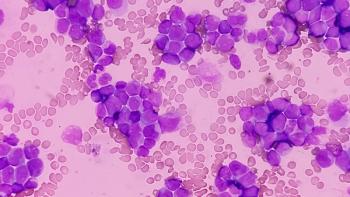
Oral Rivaroxaban Reduces VTE in Outpatient Treatment of Patients With Cancer
Rivaroxaban (Xarelto) significantly lowered the incidence of venous thromboembolism (VTE) or death due to VTE during the intervention period with the agent in patients with solid tumors or lymphoma, according to results from the CASSINI trial.
Rivaroxaban (Xarelto) significantly lowered the incidence of venous thromboembolism (VTE) or death due to VTE during the intervention period with the agent in patients with solid tumors or lymphoma, according to results from the CASSINI trial published in the New England Journal of Medicine.
These are key findings for nurses, as they play a critical role in helping patients to understand their risks for blood clots during cancer treatment or with surgical interventions, said study investigator Gary H. Lyman, MD, MPH, FASCO, FRCP, co-director, Hutchinson Institute for Cancer Outcomes Research and professor, medicine/medical oncology, University of Washington School of Medicine.
“Patients often tell nurses what’s going on, side effects they are having, what their concerns are, even before they tell their oncologists. Nurses know about these drugs, and like oncologists, we feel we need more education about the use of these. The nurse’s role is critical,” he said in an interview with Oncology Nursing News.
In the double-blind, randomized trial, the researchers evaluated the efficacy and safety of rivaroxaban in high-risk ambulatory patients with cancer (Khorana score of ≥2, on a scale from 0 to 6, with higher scores in- dicating a higher risk of venous thromboembolism). In total, 841 patients were randomized to receive either 10 mg of oral Xarelto once daily (n = 420) or a placebo (n = 421) for 180 days, with screening every 8 weeks.
“The idea of preventing these events before they occur is very attractive as long as the risk and benefit is favorable toward the benefit side. Obviously, it’s more convenient to do a pill than an injection, but we want to make sure if these were to be used, that they are safe and effective,” Lyman said.
A composite of objectively confirmed proximal deep-vein thrombosis (DVT) in a lower limb, pulmonary embolism, symptomatic DVT in an upper limb or distal DVT in a lower limb, and death from VTE served as the primary efficacy endpoint, while major bleeding comprised the primary safety endpoint.
The primary endpoint occurred in 25 patients (6.0%) in the rivaroxaban group and in 37 patients (8.8%) in the placebo arm (HR, 0.66; 95% CI, 0.40-1.09; P = .10) in the period up to day 180. During the intervention period, the efficacy endpoint occurred in 11 (2.6%) and 27 (6.4%) patients, respectively (HR, 0.40; 95% CI, 0.20-0.80).
Major bleeding occurred in 8 patients (2.0%) in the rivaroxaban group and in 4 patients (1.0%) in the placebo group (HR, 1.96; 95% CI, 0.59-6.49).
“We found that if you are a cancer patient starting outpatient chemotherapy for your cancer, with a Khorana score of 2 or higher, you have roughly a 10% risk of developing a blood clot, and we can reduce that risk by at least half if you take a blood thinner. If patients went off the drug, we found that the risk came back,” primary investigator Alok Khorana, M.D., medical oncologist at the Cleveland Clinic, said in an interview with Oncology Nursing News.
Study investigator Nicole M. Kuderer, M.D., from the University of Washington and the Division of Hematology at Seattle Cancer Care Alliance, added to the significance of these findings for ocology nurses. “Nurses are the frontline, so we need to educate our nurses about drug-to-drug interactions,” she said. “The nurses are key to keeping an eye on these drug interactions, as well as watching for bleeding episodes. They really serve as the patient educator here, too.”
Newsletter
Knowledge is power. Don’t miss the most recent breakthroughs in cancer care.
















































































